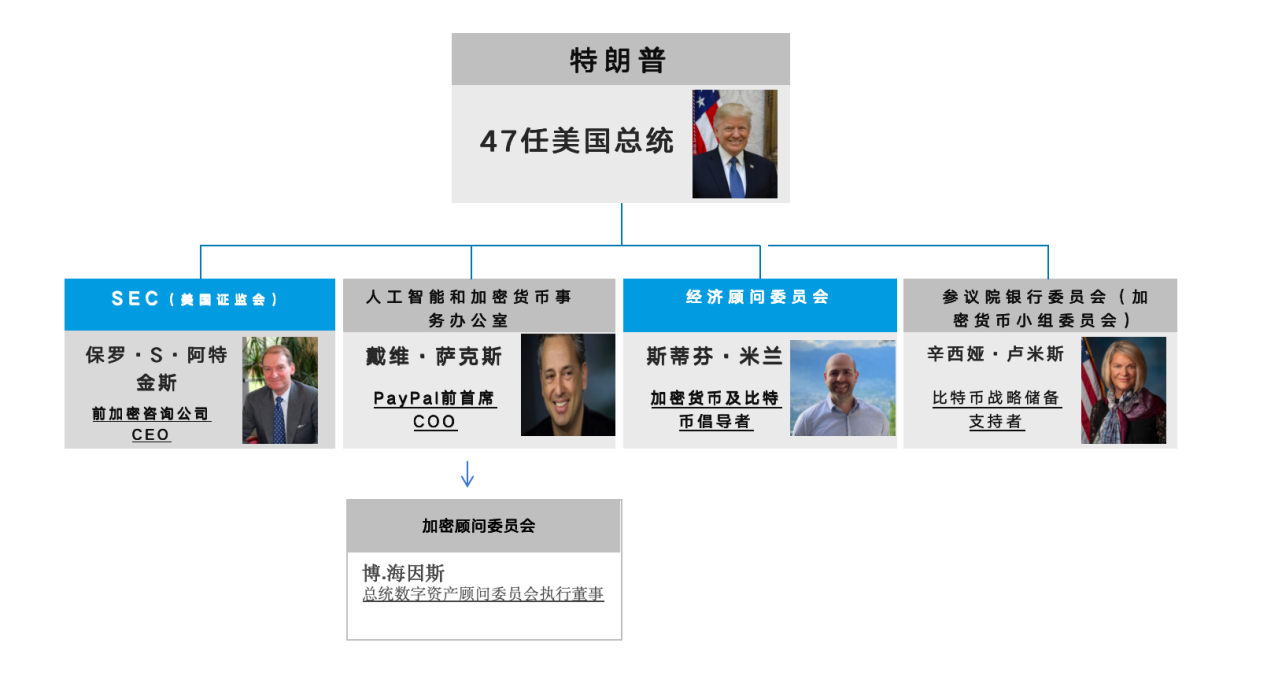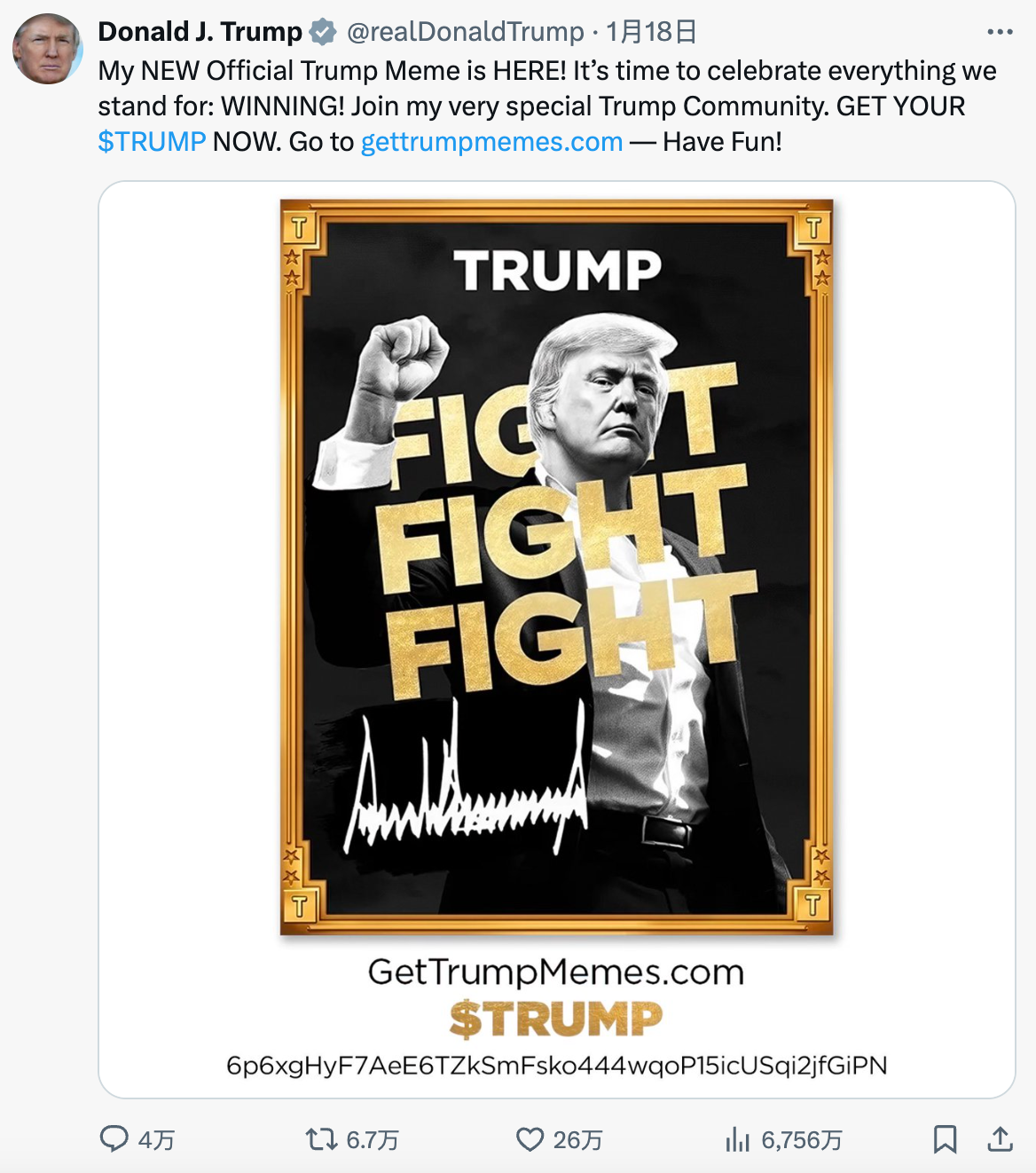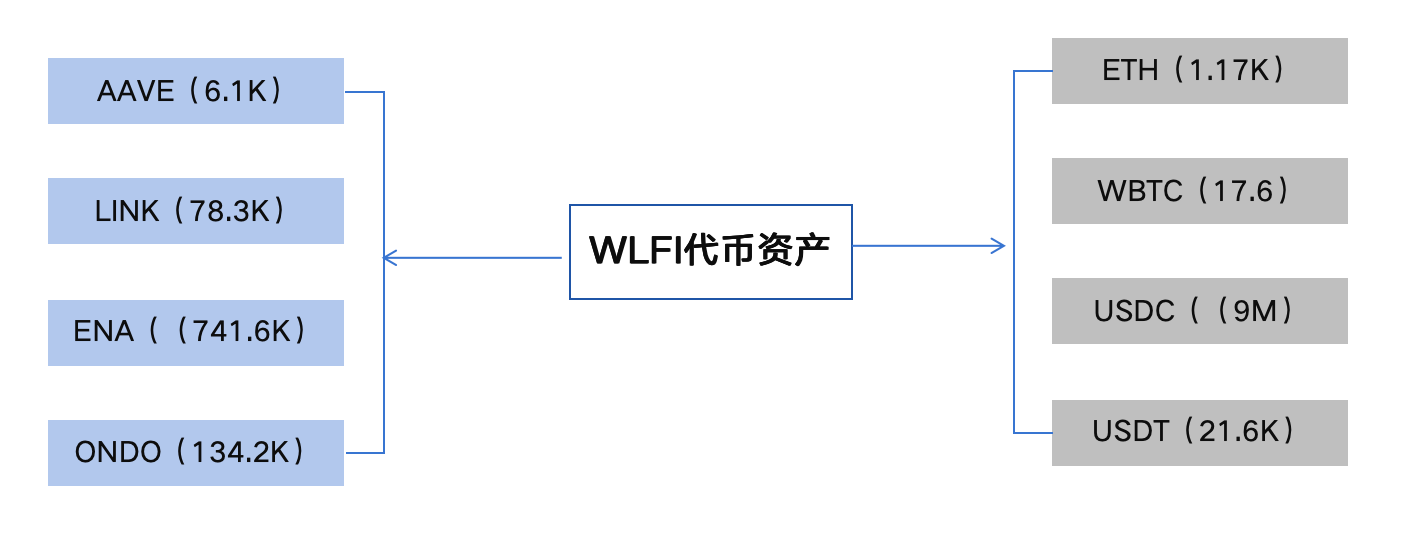1. What does Trump’s coming to power mean for the crypto industry?
The "Trump deal" since December has made the entire market boil. For the crypto industry, the focus will become how much Trump will fulfill his campaign promises. In the vacuum period of power transfer, Trump quickly nominated several key positions. The candidates for these positions will determine the direction of crypto policies in the United States and even the world in the next four years. This means that Trump's coming to power will truly change the current industry landscape. Regardless of the strength of the policy implementation, it indicates that the industry is facing new and greater opportunities and the resulting policy uncertainties.
Before Trump officially takes office, let’s first take stock of which officials have been nominated for key positions and what their attitudes and positions are towards the crypto industry.
In terms of the US political system, each president’s cabinet is mainly composed of two parts: one is the formal cabinet members who need to be confirmed by the Senate after taking office (such as the Secretary of State and other major executive department ministers); the other is cabinet-level officials, some of whom do not need Senate confirmation (such as the Chief of Staff, National Security Advisor, etc.). Therefore, at present, the institutions in the entire Trump cabinet that are directly held by crypto industry supporters or have an impact on the policy direction of the crypto industry are as follows:

From the above picture, the most concerned department in Trump's entire cabinet system is the Office of Artificial Intelligence and Cryptocurrency Affairs. The agency is currently responsible for formulating the regulatory framework for the entire crypto industry, contacting the Securities and Exchange Commission, the Commodity Futures Commission, Congress, etc. The Crypto Advisory Committee under it claims to be composed of 24 CEOs of crypto companies to provide advice on policy making. According to Trump's promise, the following new policies are worth paying attention to:
1) Make the United States the global crypto capital
2) Stop suppressing cryptocurrencies upon taking office
3) Preventing the development of central bank digital currencies (CBDCs)
4) Build a strategic Bitcoin reserve
5) Fire the SEC Chairman
6) Block the sale of Bitcoin held by the US government
7) Using Bitcoin to Solve US Debt
8) Establish a more comprehensive encryption policy
9) Establishment of a Cryptographic Advisory Committee
Judging from Trump’s personnel appointments during the transition period, at least items 5 and 9 have been completed. Whether it is the newly established advisory body, the Senate’s cryptocurrency committee, or the replacement of the SEC chairman, the crypto resumes of these promoted officials at least show that Trump is indeed fulfilling his campaign promises as planned.
For the crypto industry, at least from a regulatory perspective, on the one hand, the previously suppressed policies may be gradually relaxed, and on the other hand, more complete legislation will further promote the industry to move towards the mainstream.
2. What information does the Trump family’s first project layout reveal?
Trump's change of attitude towards cryptocurrency during his second term has indeed greatly boosted the entire industry. Not only has he set up a cabinet-level advisory team in terms of government officials, but his family has also begun to invest in the crypto industry, which has provided a certain forward-looking basis for the subsequent relaxation of the entire regulation.
At the beginning of 2025, the industry's biggest detonating project is undoubtedly the MEME coin TRUMP officially released by Trump himself. Once the project was released, it exceeded the market value of 30 billion US dollars in one day, and once again created the industry's myth of getting rich quickly.

The significance and value of Trump's personal issuance of coins is not limited to adding a star MEME to the market. To some extent, it reflects that Trump's support and depth for the crypto industry may exceed market expectations. Especially after witnessing the rapid explosion of the market value of TRUMP tokens, it may further become an important support for Trump and his cabinet departments to promote the rapid formalization of the crypto industry and relax regulations, which is undoubtedly a major benefit to the crypto industry. In addition, a potential impact behind Trump's issuance of coins this time is that the on-chain transaction volume and the myth of getting rich quickly will directly create competitive pressure on centralized exchanges, which will make the competition in the entire industry more intense.
In addition to the MEME coin launched by Trump himself, the most important project of the Trump family is World Liberty Financial (hereinafter referred to as WLFI). Although the official website of the project states that Trump, his family members and enterprises are not employees of the project, Trump's three sons are all named "ambassadors" in the project, and Trump's close ally Steve Witkof (nominated as the Middle East envoy) and his son are both co-founders of the project. In addition, the advisory team also includes partners and CEOs of well-known investment institutions in the industry such as Polychain and Scroll.
The project has been legally separated from the Trump family, but this kind of publicity, including the unremitting efforts of Trump's sons to promote the project, makes it difficult for the market not to interpret it as: This is the Trump family's project.

The WLFI project is relatively complete in terms of legal aspects. It has circumvented current regulations through various means, such as tokens are not transferable and fundraising is conducted through Regulation D Rule 506(c) of the U.S. Securities and Exchange Commission (SEC). These measures have minimized the compliance risks of the entire project. The project is still in the process of public fundraising. At present, the total token size is 20 billion, and 5.49 billion have been sold. Since the tokens are not transferable at present, the overall progress is not as expected.
In terms of the specific operation of the project, the preliminary information given is that it is a Defi project, which is mainly based on Aave to build decentralized lending. There is no relatively clear specific operation page yet. Another thing worth noting is that since the end of November, the WLFI project has begun to buy a large number of tokens. Due to its Trump endorsement, the project's token purchase has become a new market vane. Overall, the main areas and tracks involved in the project are shown in the figure below:

From the tokens held in the above figure, we can see that the WLFI project as a whole is based on its own Defi positioning. After announcing its cooperation with ENA in December 2024, the tokens it purchased, except for BTC, Ethereum and stablecoins, are mainly related to Defi. From the perspective of transactions, except for Coinbase, other major operations are carried out on CowSwap.
From the configuration of the entire team, it can be seen that most of the core team members of WLFI are from Defi background. For example, the technical director Corey Caplan previously worked on the Dolomite project, which is also a Defi project, and the chief developer Bogdan Purnavel was previously a developer of the Defi project Dough Finance.
From a series of recent actions, it can be seen that whether it is personnel deployment or the purchase of token assets, the Trump family's WLFI project as a whole still focuses on Defi, which points to some more relaxed policy expectations surrounding the Defi field.
3. What is the impact of the Trump family project on the Defi track?
Trump's MEME coin undoubtedly brings huge imagination to the market. It is rare in history that the president personally issues coins. Putting aside the consideration of interests, at least the general tone points to a loose regulatory environment for the development of the entire industry in the next four years. If we further analyze the specific operation of the project, we can see that it is not a hasty coin issuance on a whim, but has made sufficient preparations in the entire legal framework, compliance, and institutional cooperation. The certainty and super narrative of the president's coin issuance are unique, so it also creates a unique on-chain market, but the support for the industry is currently limited to loose expectations. In the long run, sustainability remains to be verified. The Trump family hopes to make WLFI a sustainable project.
From the series of operations and subsequent investments of the WLFI project, we can roughly sort out some of the advance responses made by the project based on regulatory compliance. Combined with the fact that the U.S. Internal Revenue Service proposed new DeFi tax regulations at the end of December 2024, it can be roughly inferred that relatively systematic legislative supervision may be introduced for DeFI in 2025. Although it may not be as strict as the proposals previously proposed by the U.S. Internal Revenue Service and other departments, it is foreseeable that the compliance of DeFI will become an important measure that may be implemented in 2025, such as KYC (the WLFI project also requires KYC), anti-money laundering, anti-terrorist financing, etc.
However, from a more optimistic perspective, the WLFI project, as the Trump family’s first non-MEME project, on the one hand shows optimism about the DeFi track, especially the future growth space of DeFi; on the other hand, from a policy perspective, its compliance framework was designed and considered relatively comprehensively from the beginning, which means that the project clearly knows that after Trump takes office, the relaxation of supervision and the comprehensiveness of compliance may be promoted in parallel, which will help the entire DeFI enter the mainstream vision.
Judging from Trump's own issuance of currency, the composition of his cabinet, and the DeFi projects launched by his family, at least Trump's support for the entire crypto industry has been relatively clear. However, there is still uncertainty as to what extent his regulation will be relaxed, and the market will continue to adjust its expectations around these new policies. But at least before the 2027 US mid-term elections, the resistance to the implementation of many of Trump's policies has been significantly reduced, which is a critical period that is relatively favorable for DeFi and the entire crypto industry.














